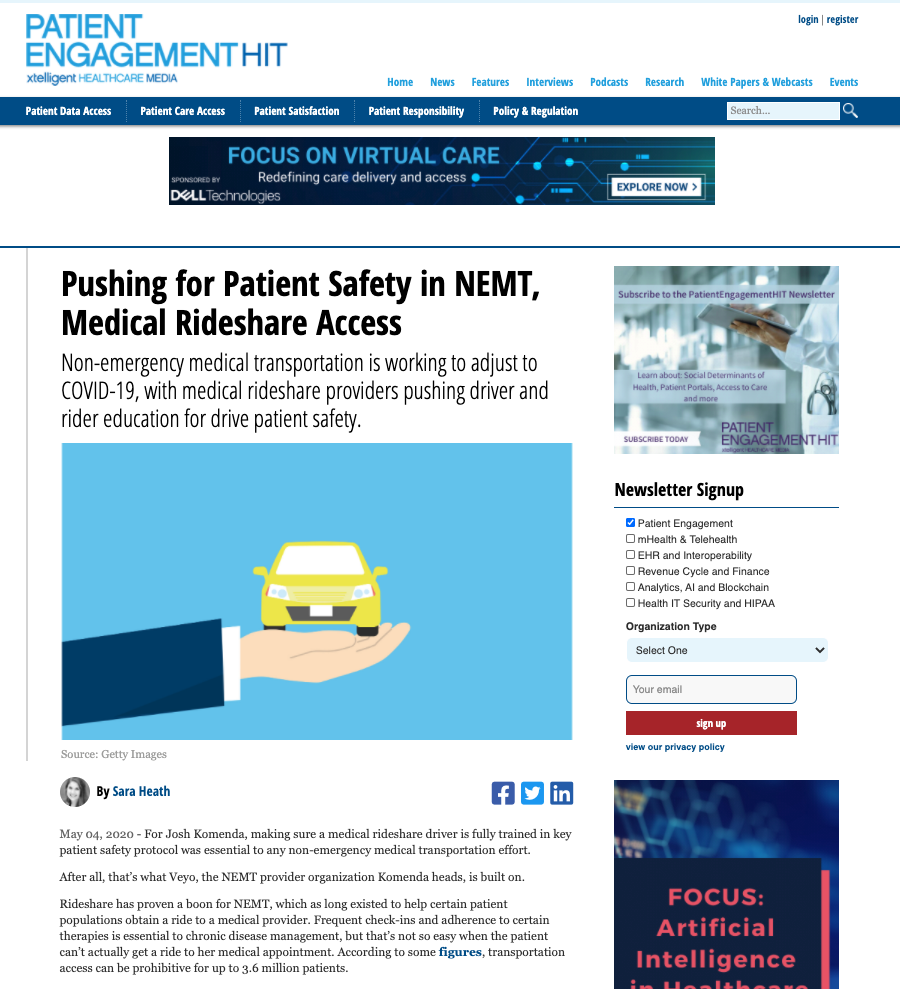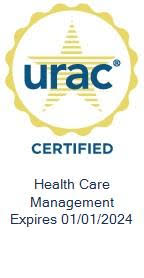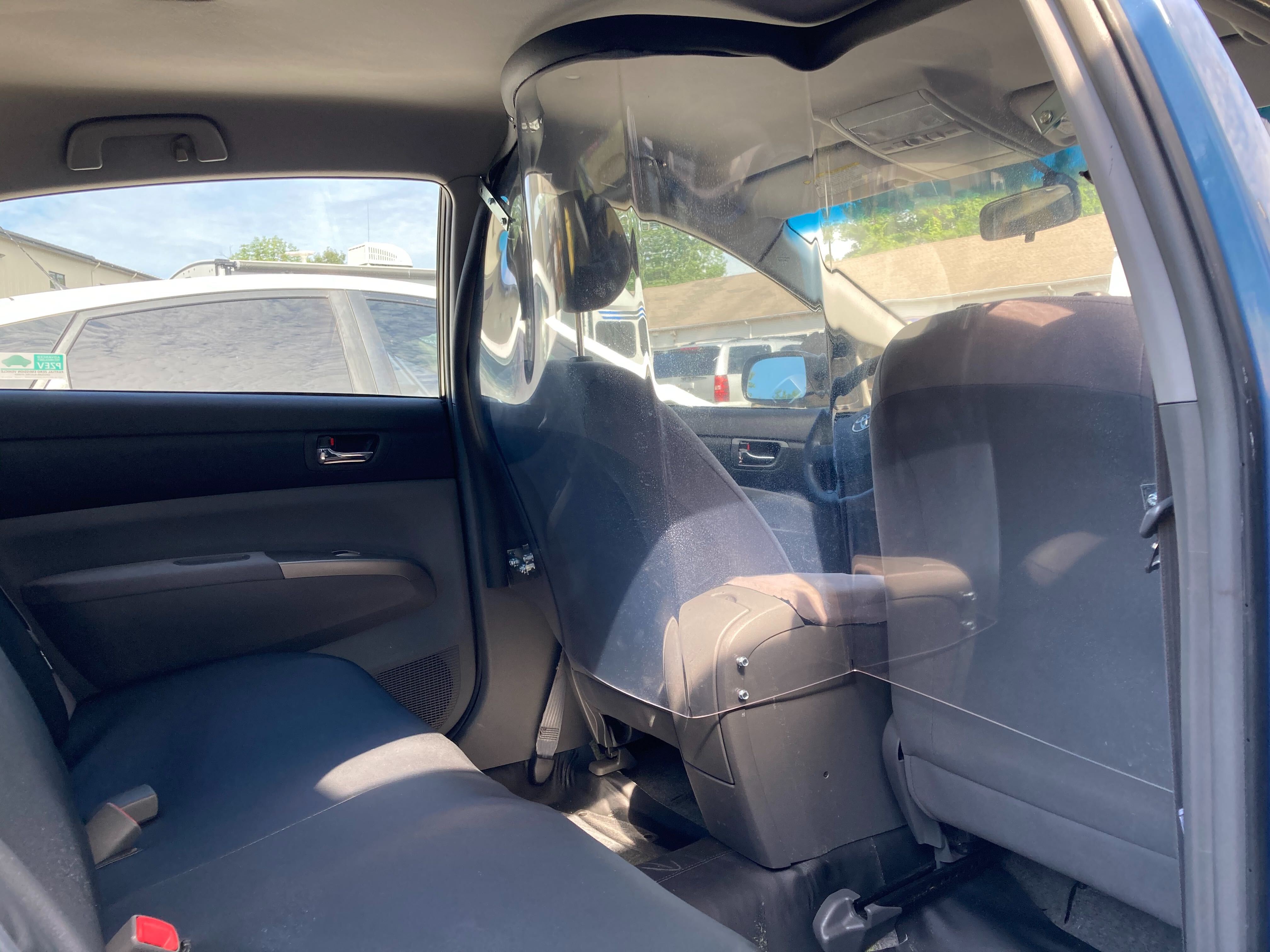Pushing for Patient Safety in NEMT, Medical Rideshare Access
August 10, 2020
Earlier this summer, Veyo was featured in Patient Engagement HIT with an interview of our President, Josh Komenda. Josh spoke on how medical rideshare and non-emergency medical transportation (NEMT) is working to adjust to COVID-19, with medical rideshare providers pushing driver and rider education for drive patient safety. The article by Sara Heath can be found here and is reprinted below.
——-
“For Josh Komenda, making sure a medical rideshare driver is fully trained in key patient safety protocol was essential to any non-emergency medical transportation effort. After all, that’s what Veyo, the NEMT provider organization Komenda heads, is built on.
Rideshare has proven a boon for NEMT, which as long existed to help certain patient populations obtain a ride to a medical provider. Frequent check-ins and adherence to certain therapies is essential to chronic disease management, but that’s not so easy when the patient can’t actually get a ride to her medical appointment. According to some figures, transportation access can be prohibitive for up to 3.6 million patients.
NEMT has stepped in to fill this gap, giving rides to patients who otherwise don’t have access to medical transportation. This benefit has been part of Medicaid coverage since 1966, and in years following has increasingly become part of private payer and Medicare benefits as well.
After all, shelling out for NEMT could be less costly than treating a patient experiencing an acute care episode after transportation issues made her forego her care.
And since then, other types of transportation providers have stepped in the fill the gaps. Consumer-facing rideshare companies, for example, proved inexpensive and effective at getting ambulatory patients to their medical appointments. A patient could hail a ride using the same app she uses to get to dinner with friends, and be dropped off in front of her medical provider.
The challenge, Komenda pointed out during a recent interview, is that some patients need a little more help than this. While they may not need a full-fledged non-emergency ambulance, using a rideshare the same way as in their consumer experiences may not serve their medical needs.
“A big part of our offering is a ride sharing type service built with Medicaid members specifically in mind, as well as an understanding of the various needs of the populations we serve,” Komenda, who is the CEO of NEMT broker Veyo, told PatientEngagementHIT.
“We serve a lot of folks who use NEMT who are living with chronic health conditions. They may be able to ambulate and get into a sedan, but they might need help with the front door or they might be living with intellectual disabilities or behavioral health challenges.”
Some medical training and patient safety protocol are essential here.
“Drivers are a specially trained and screened to manage these cases,” Komenda added. “We’re acutely aware of the variety of needs that members might have and we prioritize the basic training on working in healthcare contexts.”
In short, Komenda and his team offer something in between the commercially available rideshare offering, which many might use to get into the city for the night as well as for doctor’s appointments, and a fully loaded ambulance. While some patients may not need the bells and whistles of the latter, they do need more help than is offered on the former.
And it’s that very principle that Komenda said made his team prepared to maintain patient access to care and medical transportation once the coronavirus outbreak began.
“Approximately a month ago or about six weeks ago, we started observing what was happening and understanding that there could be very rapid operations adjustments needed to cope and contend with all the changes going on,” Komenda said of the outbreak. “Our transportation providers could work as frontline healthcare workers making sure that folks get to their appointments reliably.”
Komenda and his team put their heads together with their healthcare partners and state regulators to hammer out the operational procedures that needed to happen to make sure drivers could still serve patients.
There are a number of populations who still needed to get to medical facilities even if they did not have COVID-19 — think of dialysis patients or those in the midst of their cancer treatments — and Komenda and his team wanted to help fill this gap.
Adjusting to this forever-changed healthcare landscape required to key considerations: protecting the drivers and protecting riders. Both of these factors hinged on education and outreach on the part of Komenda and the Veyo team.
“The first thing we have done is make sure we’re operating with total transparency and making sure that everybody’s educated with all the best information that we have from official guidance,” he explained. “That includes making sure that our drivers are informed of the risks of COVID-19 and how it spreads.”
Komenda and his team reviewed safety protocol and best practices with the driver base, including the basic advice of handwashing and drivers avoiding touching their faces. Drivers were also instructed to avoid contact with riders when possible and to disinfect surfaces.
For their part, Veyo worked to provide hand sanitizer and masks for their independent driver provider (IDP) network. The NEMT provider also set up a helpline for drivers who may arrive to pick up a patient, assess the patient as too ill to ride or as displaying symptoms of COVID-19, and to hail a non-emergency ambulance.
“Any empty vehicle, whether that be part of our ridesharing network or part of our third-party partners, is not designed to move somebody with an unknown infectious disease or a person under investigation for COVID-19,” Komenda emphasized. “We’ve been working with our plans to figure out how best to do those.”
The second part of Komenda’s strategy was member education, or helping riders understand key protocol to prevent disease spread.
“When folks are calling into our call center, or interacting with drivers, what can we do to figure out if folks are having symptoms of COVID-19, if somebody in their family had them?” he posited. “We track that to make sure that we can work with our health plan and their healthcare providers if necessary, to figure out the safest way to make sure the patient got to her appointments without increasing risk to anybody else.”
The strategy doesn’t end there. As far as the coronavirus pandemic is concerned, Komenda sees potential for the IDP network to support more than just patient access to care. This is a highly trained team, he said, and they can fill in the gaps in care that are deepening at the hands of the pandemic.
“We’re working really closely with regulators and plans, and we realize there are a lot of challenges and difficult situations to work through,” he noted.
For one, Komenda is deploying the IDP network to help with senior service agencies who might serve vulnerable populations and need aid. The NEMT provider is also working with social services organizations, like Meals on Wheels and other food security groups, to help mitigate the social determinants of health coming to light during the COVID-19 pandemic.
“We have a really robust network in our in our footprint. We have networks of drivers that are healthy and able to do work and can take precautions,” Komenda concluded. “And so we realized we want to be involved in our communities and help figure out how we can help them solve all problems.””



